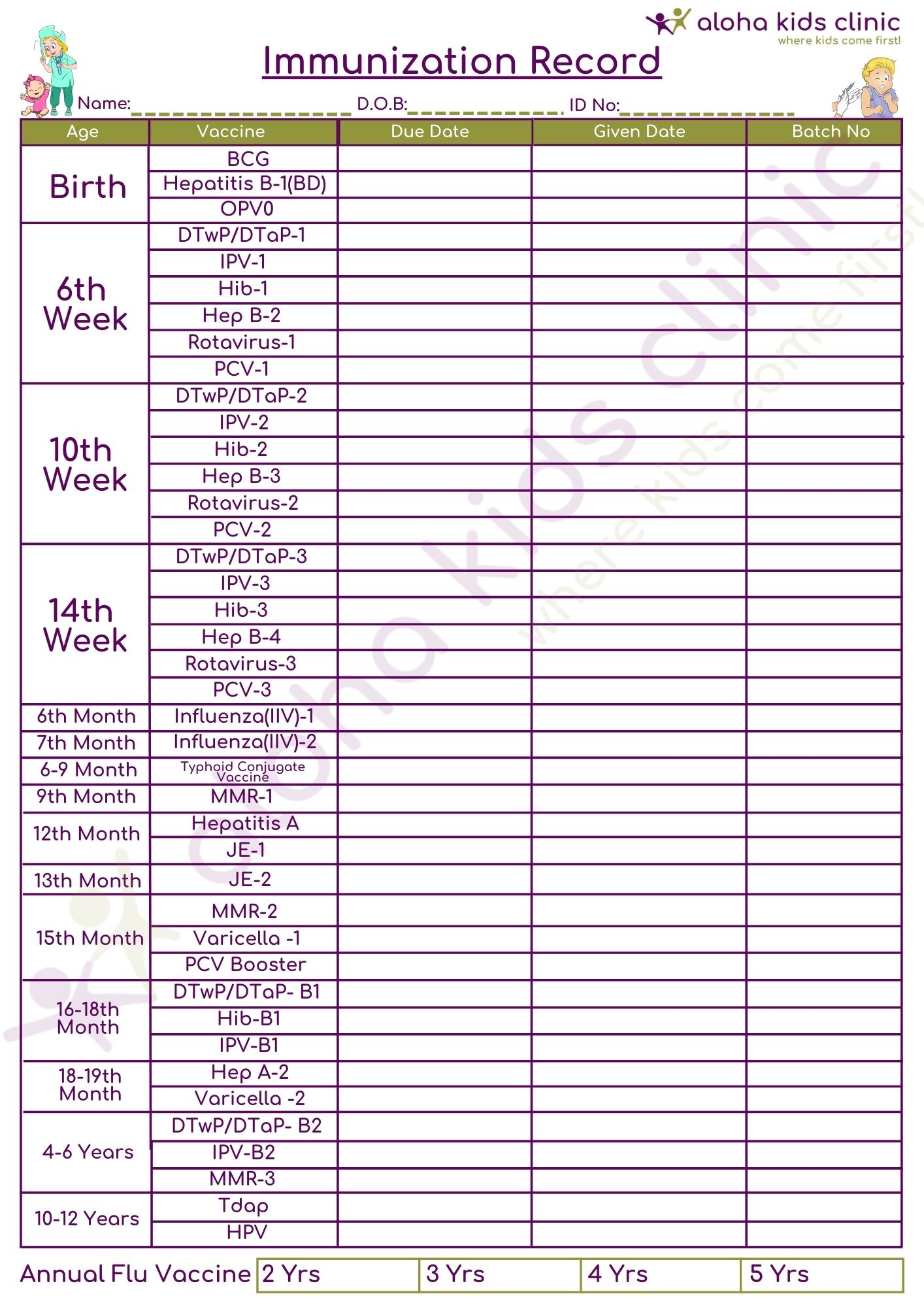Indian Vaccination Program
Understanding Your Child’ s Immunization Chart/Record
This immunization record helps you keep track of all the vaccines your child needs from birth through adolescence. Timely vaccinations protect your child from serious illnesses and support healthy growth and development.
Why is an immunization record important?
● Helps you track due dates for each vaccine.
● Prevents missed or delayed doses.
● Provides a complete record for schools, travel, and medical checkups.
● Ensures maximum protection for your child’s health.
Tip for Parents: Always bring this record to every doctor’s visit so your pediatrician can update it promptly.
Vaccination schedule as recommended by the Indian Academy of Pediatrics (IAP):

Details of Each Vaccine:
1. BCG: Protects against tuberculosis.
2. Hepatitis B: Protects against the hepatitis B virus, a cause of chronic liver infection. Given as a 3-dose series starting at birth.
3. OPV (Oral Polio Vaccine): Protects against polio.
4. DTaP/DTwP: Protects against three serious bacterial diseases — diphtheria, tetanus, and pertussis (whooping cough).
5. IPV (Inactivated Polio Vaccine): An additional injectable polio vaccine for extra protection against polio, which can cause paralysis.
6. Hib: Protects against Haemophilus influenzae type B infections, which can cause meningitis, pneumonia, and epiglottitis.
7. Rotavirus Vaccine: Protects against severe diarrhea caused by rotavirus.
8. Influenza Vaccine: Protects against seasonal influenza viruses that can cause severe respiratory illness.
9. Typhoid Conjugate Vaccine: Protects against Salmonella Typhi, which causes typhoid fever — a serious bacterial infection spread through contaminated food and water.
10. MMR: Protects against three viral diseases — measles, mumps, and rubella.
11. Hepatitis A: Protects against liver disease caused by the hepatitis A virus.
12. JE (Japanese Encephalitis Vaccines): Protects against Japanese encephalitis virus, a mosquito-borne infection that can cause brain inflammation (recommended for children in high-risk areas).
13. Varicella: Protects against chickenpox and its complications.
14. HPV (Human Papillomavirus Vaccine): Protects against HPV infections that can cause cervical and other cancers (recommended for both boys and girls).
IAP Guidelines for Vaccines in Special Situations:
CALL +91 96060 77401 to schedule the appointment today
Contact us
Call us
+91 96060 77401
Visit us at
Aloha Kids Clinic
No 531, 2nd Floor,
Nammalaya Building
Doddakallasandra,
Bangalore – 560062
Send us an email
admin@alohakidsclinic.com
About us
Subscribe
Sign up for the Aloha newsletter to receive all the news offers and discounts from the Aloha Kids clinic.
Contact us
Call us
+91 96060 77401
Visit us at
Aloha Kids Clinic
No 531, 2nd Floor,
Nammalaya Building,
Doddakallasandra,
Bangalore – 560062
Send us an email
admin@alohakidsclinic.com
About us
Subscribe
Sign up for the Aloha newsletter to receive all the news offers and discounts from Aloha Kids clinic.
Copyright by Aloha Kids Clinic,2023. All rights reserved.
Copyright by Aloha kids clinic,2023 All rights reserved.
